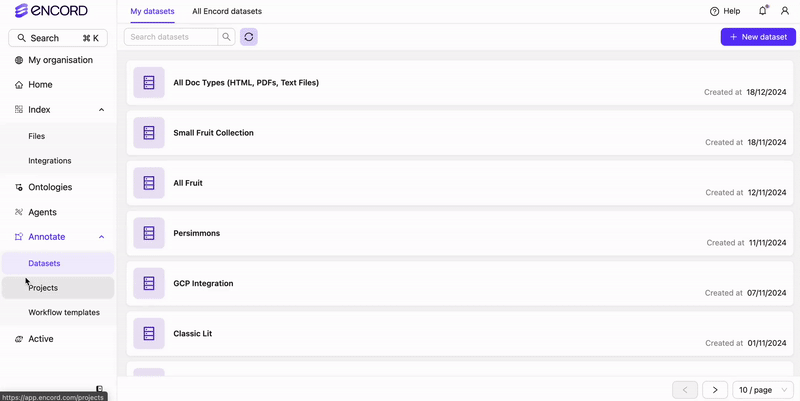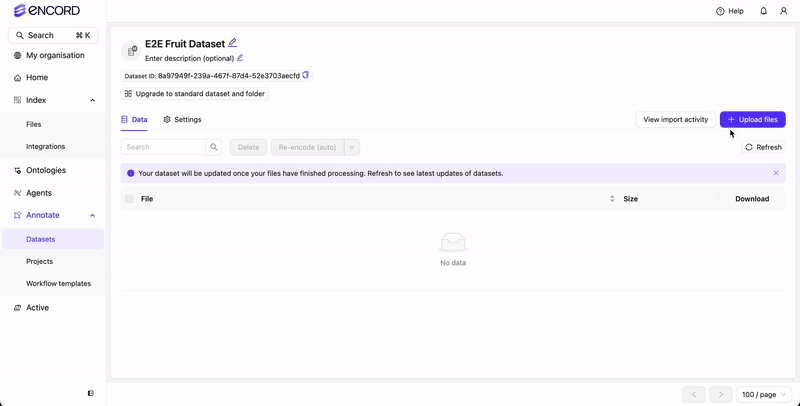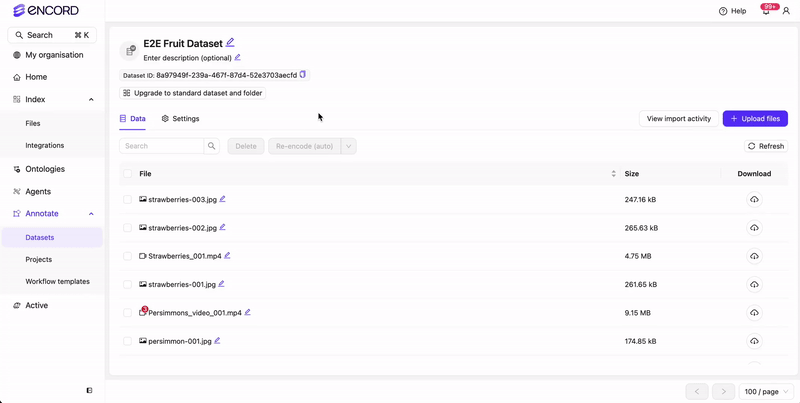Why do this?
Quick and dirty way to get going with Encord using cloud data. If you are a little more tech savvy, import your cloud data using an integration.Pros and Cons
| Pros | Cons |
|---|---|
|
|
Import Data
We’re going to import our dataset of fruit using a JSON file. The dataset is a mixture of images and videos of the following types of fruit:- Apples
- Bananas
- Blueberries
- Cherries
- Kiwi
- Persimmons
- Strawberries
1
Create Integration
Select your cloud provider.
2
Download Data
Download and extract the contents of Fruit-images-videos.zip file.
3
Import Data to Cloud Storage
Import the contents of
Fruit-images-videos.zip into your cloud storage.4
Download and Modify JSON
-
Download the
Fruit-basic-cloud-data-images-and-videos.json. -
Open the
Fruit-basic-cloud-data-images-and-videos.jsonfile and replace<file-path>with the file path to the data stored in your cloud storage.
The
Fruit-basic-cloud-data-images-and-videos.json file includes the file path and title for each image and video. It does NOT include imageMetadata, videoMetadata or clientMetadata.5
Create a Mirrored Dataset
Create a mirrored Dataset using the UI. Using mirrored Datasets is the simplest way get data into Encord for annotation. Mirrored Datasets provide no method of curating or managing your data.Mirrored datasets sync all the data to your Dataset automatically. This means if you want to add more data to your Dataset, you can add more data to the Dataset and then data automatically gets added to your Annotate Project.

6
Import Data
Import the data, from 
Fruit-images-videos.zip, using the Fruit-basic-cloud-data-images-and-videos.json to the mirrored Dataset.
7
Re-encode Videos

8
Create Project
Once all the videos are re-encoded you are ready to create an Annotate Project. Once you create a Project and you and your team are ready to begin annotating the data.Performing ANY of these tasks results in creating the Project 






E2E Fruit Project to annotate.- The Ontology is the same for ALL tasks.
- The Workflow varies depending on the task.
Create Project - UI
Create Projects (Ontologies, Workflows, and Projects) using the Encord UI.
Create Project - SDK
Create Projects (Ontologies, Workflows, and Projects) using the SDK.
Create Consensus Project - UI
Create Consensus Projects (Ontologies, Workflows, and Projects) using the UI.
Create Consensus Project - SDK
Create Consensus Projects (Ontologies, Workflows, and Projects) using the UI.
Create Project - Import Labels
Create Projects (Ontologies, Workflows, and Projects) for use with your own labels.
Create Project - Import Predictions
Create Projects (Ontologies, Workflows, and Projects) for use with your own model predictions.
Create Project - Task Agents
Create Projects (Ontologies, Workflows, and Projects) for use with Task Agents.

